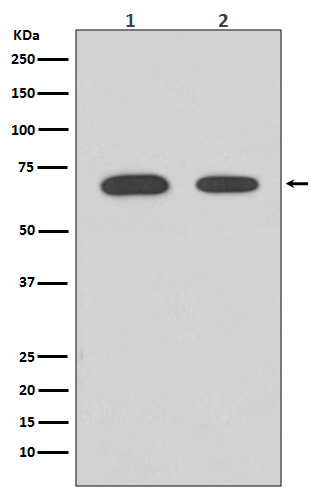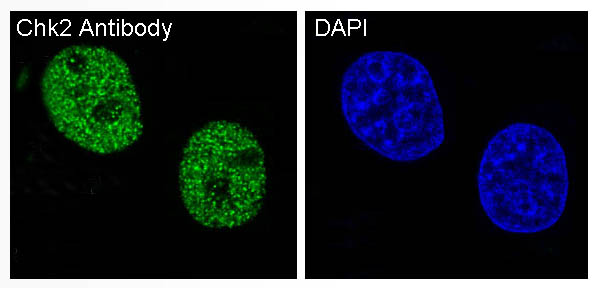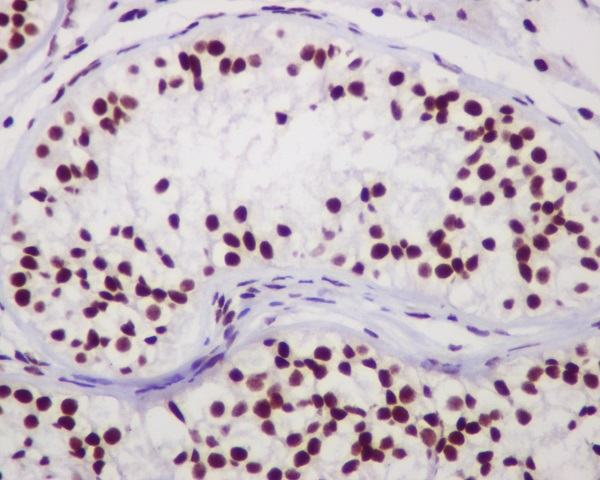


| WB | 1/500-1/1000 | Human,Mouse,Rat |
| IF | 1/20 | Human,Mouse,Rat |
| IHC | 1/50-1/100 | Human,Mouse,Rat |
| ICC | 1/50-1/200 | Human,Mouse,Rat |
| FCM | 咨询技术 | Human,Mouse,Rat |
| Elisa | 咨询技术 | Human,Mouse,Rat |
| Aliases | CHEK2; CDS1; CHK2; RAD53; Serine/threonine-protein kinase Chk2; CHK2 checkpoint homolog; Cds1 homolog; Hucds1; hCds1; Checkpoint kinase 2 |
| Entrez GeneID | 11200 |
| WB Predicted band size | Calculated MW: 61 kDa; Observed MW: 61 kDa |
| Host/Isotype | Rabbit IgG |
| Antibody Type | Primary antibody |
| Storage | Store at 4°C short term. Aliquot and store at -20°C long term. Avoid freeze/thaw cycles. |
| Species Reactivity | Human |
| Immunogen | A synthesized peptide derived from human Chk2 |
| Formulation | Purified antibody in PBS with 0.05% sodium azide. |
+ +
以下是关于Chk2抗体的3篇参考文献及其摘要内容的简要概括:
1. **文献名称**:*"Activation of the ATM kinase by ionizing radiation and phosphorylation of Chk2"*
**作者**:Hirao, A. et al.
**摘要**:该研究利用Chk2特异性抗体揭示了DNA双链断裂后ATM激酶激活Chk2的分子机制,并证实Chk2的磷酸化修饰在细胞周期检查点调控中的关键作用。
2. **文献名称**:*"Regulation of the Chk2 kinase by the FHA domain and phosphorylation"*
**作者**:Matsuoka, S. et al.
**摘要**:通过Chk2抗体进行免疫共沉淀实验,研究揭示了Chk2激酶的FHA结构域与其磷酸化依赖性蛋白相互作用的关联,阐明了其在DNA损伤信号传导中的功能。
3. **文献名称**:*"Phospho-specific antibodies reveal spatiotemporal dynamics of Chk2 activation in response to DNA damage"*
**作者**:Antony, M. et al.
**摘要**:该研究开发了针对Chk2磷酸化位点的特异性抗体,用于检测不同DNA损伤条件下Chk2的活性变化,揭示了其在细胞核内动态激活的时空特征。
4. **文献名称**:*"Chk2 kinase: a busy messenger"*
**作者**:Bartek, J. & Lukas, J.
**摘要**:综述性文章,总结了Chk2在DNA损伤应答中的核心作用,并强调了通过抗体技术研究Chk2表达及修饰在癌症模型中的重要性。
(注:以上文献信息为示例性概括,实际引用需以具体发表的论文内容为准。)
Chk2 (Checkpoint kinase 2) is a serine/threonine kinase critical for maintaining genomic stability in response to DNA damage. It is a key component of the DNA damage response (DDR) pathway, activated primarily by the upstream kinase ATM (ataxia-telangiectasia mutated) following double-strand DNA breaks. Upon activation, Chk2 phosphorylates numerous downstream targets, including p53. BRCA1. and CDC25. to regulate cell cycle arrest, DNA repair, and apoptosis. This ensures cells either repair damaged DNA or undergo programmed death if damage is irreparable, preventing genomic instability and carcinogenesis.
Chk2 antibodies are essential tools for studying its expression, activation, and interaction networks in both physiological and pathological contexts. These antibodies are widely used in techniques like Western blotting, immunohistochemistry, and immunofluorescence to detect Chk2 protein levels, phosphorylation status (e.g., at Thr68. a marker of activation), and subcellular localization. Commercially available Chk2 antibodies are often developed using immunogens derived from conserved regions of human Chk2. ensuring cross-reactivity in common model organisms like mice and rats.
Dysregulation of Chk2 is implicated in cancer, as germline mutations in the CHEK2 gene are linked to inherited cancer syndromes (e.g., Li-Fraumeni-like syndrome) and increased susceptibility to breast, prostate, and colorectal cancers. Research using Chk2 antibodies has advanced understanding of its tumor-suppressive roles, therapeutic resistance mechanisms, and potential as a biomarker or target in precision oncology. Validation of antibody specificity via knockout controls remains critical due to homology with Chk1 and other kinases.
×